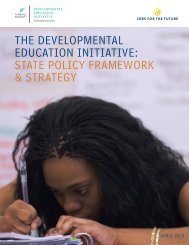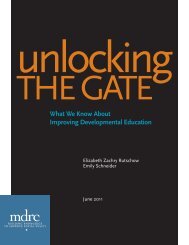leadership roles, and community involvement as contributing to student success at thepostsecondary level.The current study emphasizes the traditional view of college readiness, whichfocuses on academic readiness in math and English, but we also included examples ofpartnerships and programs that used broader definitions of college readiness, in particularthose designed to increase “college knowledge.”<strong>Students</strong> at Risk of Not Being <strong>College</strong> ReadyWhile college readiness may be an issue <strong>for</strong> a range of students, there is reason <strong>for</strong>particular concern <strong>for</strong> students in the “academic middle.” These students are likely tograduate high school intending to go to college but are at higher risk of being placed intodevelopmental education upon enrollment (Kirst & Venezia, 2001). Many have difficultyobtaining adequate support in selecting the right college, applying <strong>for</strong> admission andfinancial aid, and preparing themselves <strong>for</strong> the transition into college (Kirst & Venezia,2001). The current research focuses on partnerships and programs that serve students at riskof entering college underprepared.Effective <strong>College</strong> Readiness ProgramsA review of the existing research literature reveals that pre-college interventionsmay help students in the academic middle improve their college readiness and reduce theneed <strong>for</strong> remediation by addressing academic and skill deficits (Cunningham, Redmond, &Merisotis, 2003; Fenske, Geranios, Keller, & Moore, 1997; Gándara, 2001; Gullatt & Jan,2003; Perna, Fenske, & Swail, 2000). However, there have been few rigorous evaluations ofprogram effectiveness, and relatively little is known about how well these programs work.After reviewing evaluations of large numbers of intervention programs to identify those thatwould permit an assessment of the effectiveness of particular models and features, Gándara(2001) identified only 13 out of 97 program evaluations that met an acceptable level ofrigor. 3 In examining these, she found that the single most important influence on positivestudent outcomes was a close, caring relationship with a knowledgeable adult. Otherimportant features included high quality instruction, longer program length, attention tostudents’ cultural background, and scholarship aid.3 Schultz and Mueller (2006) per<strong>for</strong>med a subsequent review to update findings <strong>for</strong> the programsdiscussed by Gándara (2001) and to identify any additional programs that had acceptable evidence ofeffectiveness; they found an additional seven evaluations that met their standard. According to theseresearchers, high quality evaluation designs include experimental and other designs that allow evaluatorsto attribute any possible impacts to the program.4
There is some evidence in the literature that college readiness programs withpositive impacts tend to combine a variety of services. Researchers suggest that effectiveprograms provide academic preparation and scaffolding through rigorous coursework,tutoring, and the creation of personalized learning environments (Cunningham et al., 2003;Gullatt & Jan, 2003; Shultz & Mueller, 2006). In addition, effective programs providestudents with opportunities to gain college knowledge, which includes the in<strong>for</strong>mationneeded to prepare <strong>for</strong> and apply to college and the social and cultural skills needed to besuccessful once enrolled (Constantine, Seftor, Martin, Silva, & Myers, 2006). Finally, socialguidance and support, including mentoring, counseling, advising, and motivationalactivities, are often offered by strong college access and enrichment programs (Perna, 2000;Shultz & Mueller, 2006). However, the cost of providing multiple services can be high, andthe literature on the cost-effectiveness of college readiness programs is almost nonexistent(Perna, 2007).The Value of CollaborationThe past decade has witnessed a significant increase in both statewide and nationalsecondary–postsecondary partnership ef<strong>for</strong>ts, especially around P-16 policy re<strong>for</strong>m and thealignment of academic standards and assessments (Achieve, Inc., 2006; McRobbie, 2004;Pathways to <strong>College</strong> Network, 2007). While college readiness partnerships havetraditionally involved local relationships between K-12 schools and community colleges,they have recently begun to include wider-ranging collaborations <strong>for</strong> successful studenttransitions (Bueschel, 2003; McRobbie, 2004). In Texas, <strong>for</strong> example, a statewide Texas P-16 Council was established in 2003 to ensure that long-term plans and goals established byelementary and secondary education are coordinated with those of higher education.<strong>College</strong> readiness partnerships between secondary and postsecondary institutionsmay result in mutual benefits. Working in coordination, institutions can maximize eachother’s effectiveness in improving outcomes <strong>for</strong> students (Gándara, 2001; McCants, 2004;Perna & Swail, 2001; State <strong>High</strong>er Education Executive Officers, 2003). Postsecondarypartners may benefit from reduced costs <strong>for</strong> student remediation and additionalopportunities <strong>for</strong> student recruitment (McRobbie, 2004). <strong>High</strong> schools may increase theireffectiveness in preparing students <strong>for</strong> college success. In addition, these partnerships canenhance alignment of academic standards and assessment, encourage better data-sharingpractices, and facilitate cross-system faculty development (Bueschel, 2003; Mazingo,MacNeill, Roberts, & Shackle<strong>for</strong>d, 2004).5
- Page 1: Preparing High SchoolStudents for C
- Page 4 and 5: The National Center for Postseconda
- Page 7 and 8: ContentsOverviewList of ExhibitsPre
- Page 9: List of ExhibitsTable3.1 Number of
- Page 13 and 14: AcknowledgmentsThe authors of this
- Page 15 and 16: Executive SummaryIn his 2009 State
- Page 17 and 18: Summer bridge programs, generally o
- Page 19 and 20: Figure ES.1College Readiness Partne
- Page 21 and 22: lack of funding streams that reward
- Page 23 and 24: Chapter 1IntroductionIn his 2009 St
- Page 25: partnerships formed by K-12 school
- Page 29 and 30: In addition, the Texas legislature
- Page 31 and 32: Chapter 2Research Design and Method
- Page 33: The goal of the site visits was to
- Page 36 and 37: Program CategoryTexas College Readi
- Page 38 and 39: Key Characteristics of State and Lo
- Page 40 and 41: equired by state law, 8 and incorpo
- Page 42 and 43: ensure that every high school senio
- Page 44 and 45: the summer. Staff members at some o
- Page 46 and 47: these situations, a community-based
- Page 48 and 49: easons to work together, policy cha
- Page 50 and 51: Lack of Incentives for Community Co
- Page 52 and 53: Implications for College Readiness
- Page 54 and 55: programming and create a more cost-
- Page 57 and 58: This appendix includes a short desc
- Page 59 and 60: Length/duration: Approximately 20 s
- Page 61 and 62: campus resources (including the lib
- Page 63 and 64: College Connection Advisors Program
- Page 65 and 66: Length/duration: The program runs f
- Page 67 and 68: their personal online portfolios, w
- Page 69 and 70: program are that at least 80 percen
- Page 71: Appendix BScan Summary of LocalColl
- Page 74 and 75: Appendix Table B.1 (continued)Progr
- Page 76 and 77:
Appendix Table B.1 (continued)Progr
- Page 79 and 80:
ReferencesAchieve, Inc. (2006). Clo
- Page 81 and 82:
Kirst, M., & Venezia, A. (2001). Br
- Page 83:
Texas Higher Education Coordinating





